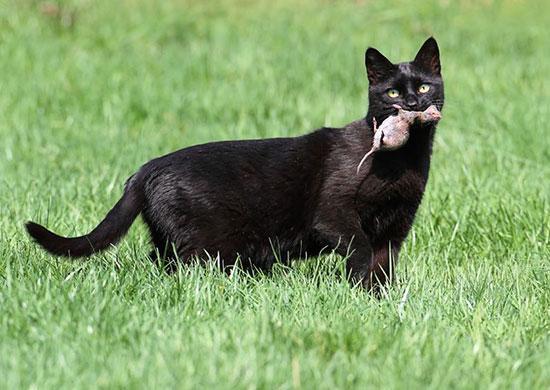This content is archived from the Feline Nutrition Foundation
Answers: Raw Food and Outdoor Cats, What About Worms?
- Updated: Monday, May 06, 2019 03:31 PM
- Published: Wednesday, November 28, 2012 01:18 PM
- Written by Guillermo Díaz. MV
 My kitty eats a raw cat food diet that includes chicken, turkey, rabbit and sometimes a little beef. She is also allowed outside and will catch and eat mice and occasionally other small rodents. Could she get worms from this wild prey? If she can, how often should we get her checked for worms?
My kitty eats a raw cat food diet that includes chicken, turkey, rabbit and sometimes a little beef. She is also allowed outside and will catch and eat mice and occasionally other small rodents. Could she get worms from this wild prey? If she can, how often should we get her checked for worms?
Unfortunately, eating wild prey can result in your cat getting internal parasites such as roundworms, tapeworms, hookworms, trichinella, coccidia, or being exposed to protozoa, bacteria and viruses.
A parasite is an organism that has a symbiotic relationship with its host. However, the relationship is at the host's expense, as the parasite can live within or on the outside of a cat. Seldom is their intent to harm the host, as this would jeopardize their own existence. In nature, young or weak animals may succumb to the side effects of a parasite by infection – a part of natural selection.
Ingestion of raw meat might be a source of infection, predominantly from wild, whole prey and game meats. Infection through an intermediate host such as fleas, mosquitoes and ticks is also possible. Plus, cats can accidentally ingest feces, soil or contaminated water.
As a veterinarian, I'm convinced that the ingestion of raw meat from captive livestock and captive-raised prey animals represent a very small risk of parasite contraction. Their risk of disease due to not eating a raw cat food diet is far greater.
The prevalence of parasites in cats is high, up to 40% or more.¹ Kittens can become infected with parasites before they are born if the mother had a dormant infection. Parasites can even be passed through the queen's milk.
What Kind of Worms and Parasites Can My Cat Get from Eating Wild Prey?
Roundworms
Roundworms are the most common intestinal parasites in cats.² There are two different types, Toxocara cati and Toxascaris leonina. Eggs from these worms are passed in the feces and can be ingested by other cats. Eggs can remain infective within the environment for months to years. Infection can also be passed by an intermediate host, such as rodents, that have eaten the eggs and in turn are eaten by a cat.³
Toxocara cati is also passed through the milk of the queen to her kittens. Whenever a queen is infected with roundworm, larvae remain dormant in certain tissues in the body. This causes no harm to the queen. However, when she gives birth, the larvae migrate to the mammary glands and are excreted in the milk. This is a common route of infection. Most kittens will be infected with Toxocara cati.⁴ Many adult cats also shed this worm in their feces.
Tapeworms
 Tapeworms are long flat worms composed of many segments, like the wagons of a train. Segments containing worm eggs are passed in the feces. These segments resemble grains of rice. They can sometimes be seen on the hair around the anus of the cat, in the feces and on the cat's bed. When they come out of the host cat after defecation, they move, similar to crawling, in order to lay their eggs along the way.
Tapeworms are long flat worms composed of many segments, like the wagons of a train. Segments containing worm eggs are passed in the feces. These segments resemble grains of rice. They can sometimes be seen on the hair around the anus of the cat, in the feces and on the cat's bed. When they come out of the host cat after defecation, they move, similar to crawling, in order to lay their eggs along the way.
The most common types of tapeworm that infect cats are Dipylidium caninum and Taenia taeniaeformis. Dipylidium is transmitted to cats by fleas. Immature fleas ingest the eggs of the worm and infection is passed on to a cat when swallowed during grooming. You should assume that any cat infected with fleas also has Dipylidium, and vice versa.
Taenia taeniaeformis, is passed on to cats by small rodents such as rats and mice. Worm eggs are eaten by rodents and then passed on to cats when they eat their prey after a hunt.
Hookworms
Intestinal parasites similar to tapeworms and roundworms, hookworms attach to the lining of the intestine and feed off your cat's blood. Internal bleeding results and may cause anemia and severe diarrhea. Cats can become infected with hookworm larvae by ingesting contaminated soil, water or an infected prey animal. Hookworms can also infect cats by burrowing directly through the skin or being passed to kittens while nursing.⁵ There are two main types, Ancylostoma and Uncinaria.They can infect both cats and dogs.
Trichinella
This is a parasite that cats may ingest when consuming raw prey. Trichinella spiralis is a small nematode approximately one millimeter long. The larvae cause disease when encysted in muscle tissue, with a resulting loss of function. Cats probably become infected during predation, because rodents harbor a background level of infection.⁶
Coccidia
Cats can become infected with coccidia by ingesting soil that contains the single-celled parasite, or by eating a rodent that is infected with it. Coccidiosis frequently causes diarrhea and can affect cats of any age, but it is usually more severe in kittens.
How Can I Know if my Cat is Infected with Parasites? What Symptoms Should I Look For?
Your cat may be heavily infested with roundworms if he has a dull or unhealthy coat and a potbelly. Young cats can experience weight loss, diarrhea, vomiting and a failure to thrive. Your cat may cough if roundworms move into his lungs. Other symptoms you should look for: depression, dehydration and in the most severe cases, anemia. Generally, cats do not show symptoms when infected with tapeworms or trichinella. Symptoms of a hookworm infection can be weight loss and diarrhea.
How Often Should I Deworm My Cat?
 Most veterinarians recommend that adult cats be dewormed only when there is specific evidence of an infestation. A microscopic stool examination is the most effective way of making an exact diagnosis and to choose the best deworming agent.
Most veterinarians recommend that adult cats be dewormed only when there is specific evidence of an infestation. A microscopic stool examination is the most effective way of making an exact diagnosis and to choose the best deworming agent.
Cats of all ages, particularly those who hunt and roam freely, can be subject to periodic heavy worm infestations. These cats should be tested once or twice a year, and treated when needed. It is reasonable to deworm outdoor cats routinely for ascarids and tapeworms even without a positive stool sample. Many anthelmintics are safe for repeat use. Tapeworms segments may be seen frequently, and treated when discovered. Cats with tapeworms may need to be treated as often as four or five times a year.
A queen should have her stool checked before breeding. If parasites are found, she should receive a thorough deworming. This will not protect her kittens from all worm infestations, but it will decrease the frequency and severity of any parasite infestation. It will also help to put her in the best condition for a healthy pregnancy.
Side Effects
Side effects in adult cats from deworming are usually seen within 24 hours of taking a deworming medicine, but are usually rare. Cats that have more side effects are those that are young, weak or ill. Cats with kidney problems are also more prone to suffer from side effects after treatment.
The most common side effects are:
- Vomiting
- Loss of appetite
- Increased salivation
- Diarrhea
Other side effects after deworming can include lethargy and non-alertness. One may also notice worms in the cat's stool. Side effects that should receive veterinary care within a day of the cat taking the medication include non-alertness, twitching, vomiting within an hour after taking the dewormer and irritability.
Worming Products
There are many different worming products available at supermarkets, pet shops and veterinary practices. It is important to obtain the advice of your veterinarian before deciding which one to use. Some worming medications are effective against both roundworm and tapeworm, while others are only effective against one or the other. With your veterinarian's advice, worming your cat regularly and treating against fleas will ensure the health risk is minimal.
Additional Reading
How Toxoplasmosis Affects Cats
Answers: Cat Urine Ph, Why It Matters
What Can I Do to Prevent My Cat from Getting Infected with Parasites?
- Keeping your cat indoors will reduce his ability to catch and eat wild prey.
- If your cat has free run outdoors and eats wild rodents, have your veterinarian examine a stool sample for intestinal parasites every six months.
- Use de-worming medication as recommended by your veterinarian when necessary.
- Clean litter boxes promptly and thoroughly.
- Purchase meat directly from reputable sources.
While these measures reduce the risk, they don't eliminate it entirely. Indoor cats will still have the opportunity to catch prey that make it inside, and even indoor cats may be exposed to fleas.
Note: Feline Nutrition provides feline health and nutrition information as a public service. Diagnosis and treatment of specific conditions should always be in consultation with your own veterinarian. Feline Nutrition disclaims all warranties and liability related to the veterinary advice and information provided on this site.
Dr. Guillermo Díaz and family, including their four dogs (Leroy, Xica, Moza and Pepa) and six cats (Michalina, Tigger, Vladimir, Yellow, Mongo and Chirusa) moved to Buenos Aires, Argentina in July of 2017, where he expects to continue supporting different animal rescue groups, spread the benefits of raw food for cats and dogs and write articles about nutrition.
1. "Gastrointestinal Parasites of Cats," Cornell University College of Veterinary Medicine.
2. "Roundworms," Companion Animal Parasite Council, 2012.
3. Donato Traversa, Department of Comparative Biomedical Sciences, University of Teramo, Teramo, Italy, "Pet Roundworms and Hookworms: A Continuing Need for Global Worming," Parasites and Vectors, May 10, 2012.
4. JC Parsons, "Ascarid Infections of Cats and Dogs," The Veterinary Clinics North America, Small Animal Practice 17, no. 6, Nov 1987, 1307-39.
5. Donato Traversa, Department of Comparative Biomedical Sciences, University of Teramo, Teramo, Italy, "Pet Roundworms and Hookworms: A Continuing Need for Global Worming," Parasites and Vectors, May 10, 2012.
6. "Parasites - Trichinellosis, Biology," Centers for Disease Control and Prevention, August 8, 2012.




